International Corporate Finance: UK & Unilever Analysis Report
VerifiedAdded on 2023/01/03
|13
|4291
|32
Report
AI Summary
This report provides a comprehensive analysis of international corporate finance, focusing on both country-level and firm-level perspectives. The country-level analysis examines the international monetary environment of the United Kingdom, including its history, exchange rate regime, and the role of the central bank. It also discusses the impact of the 2008 global financial crisis on the UK's economy and provides an overview of the country's currency in the foreign exchange market. The firm-level analysis centers on Unilever, evaluating its capital structure, cost of capital, share price, and the relationship between its performance and the FTSE100 index. The report utilizes economic theory to explain the financial dynamics and concludes with a summary of key findings and implications. The report covers various topics such as discussion of international monetary environmental, impact of global finance crisis and overview of currency of country. Apart from this, discussion of cost of capital of country and its implications, changes in share price of the company, economic and financial theory, relationship between the performance of company and market benchmark are also covered in this assignment.
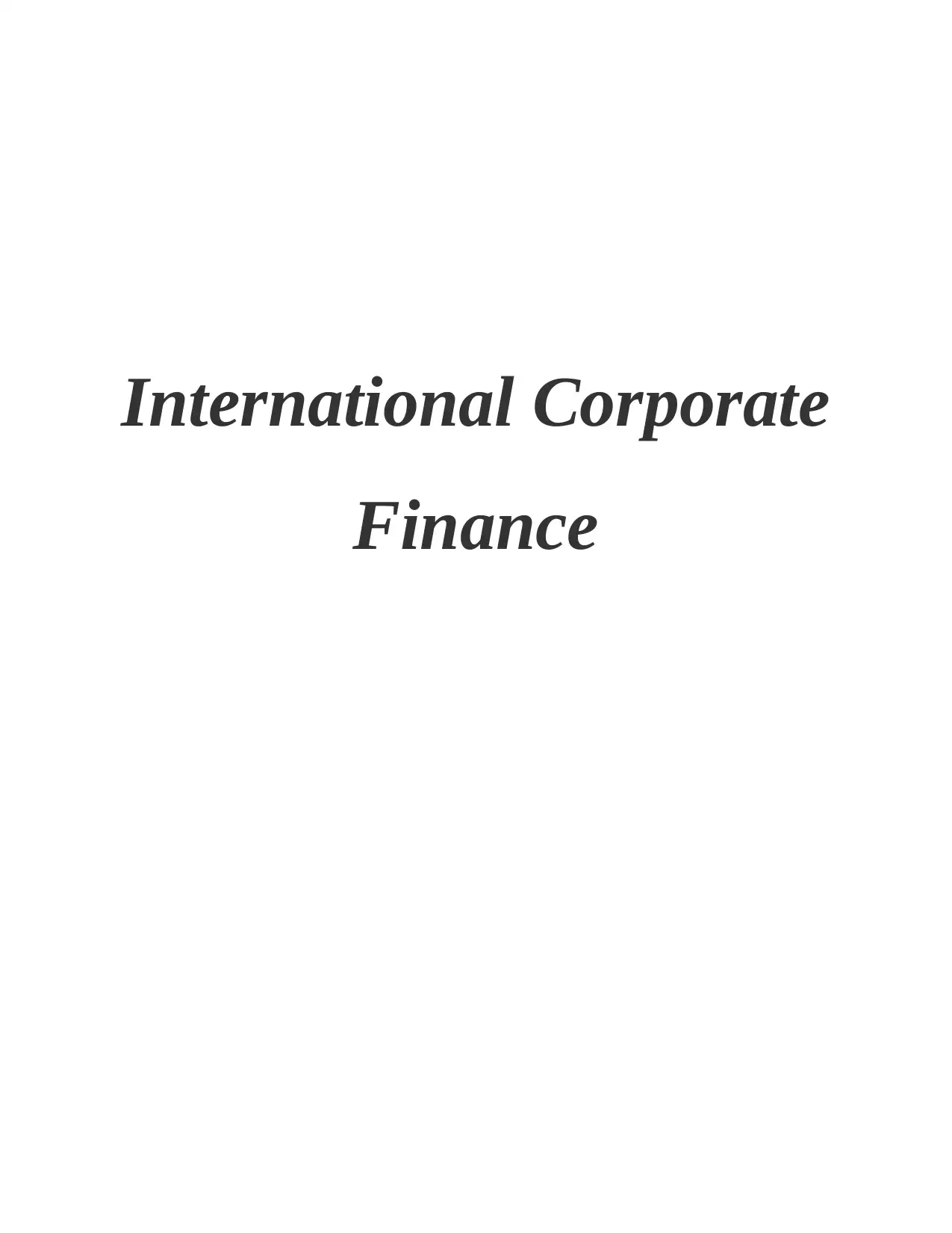
International Corporate
Finance
Finance
Paraphrase This Document
Need a fresh take? Get an instant paraphrase of this document with our AI Paraphraser
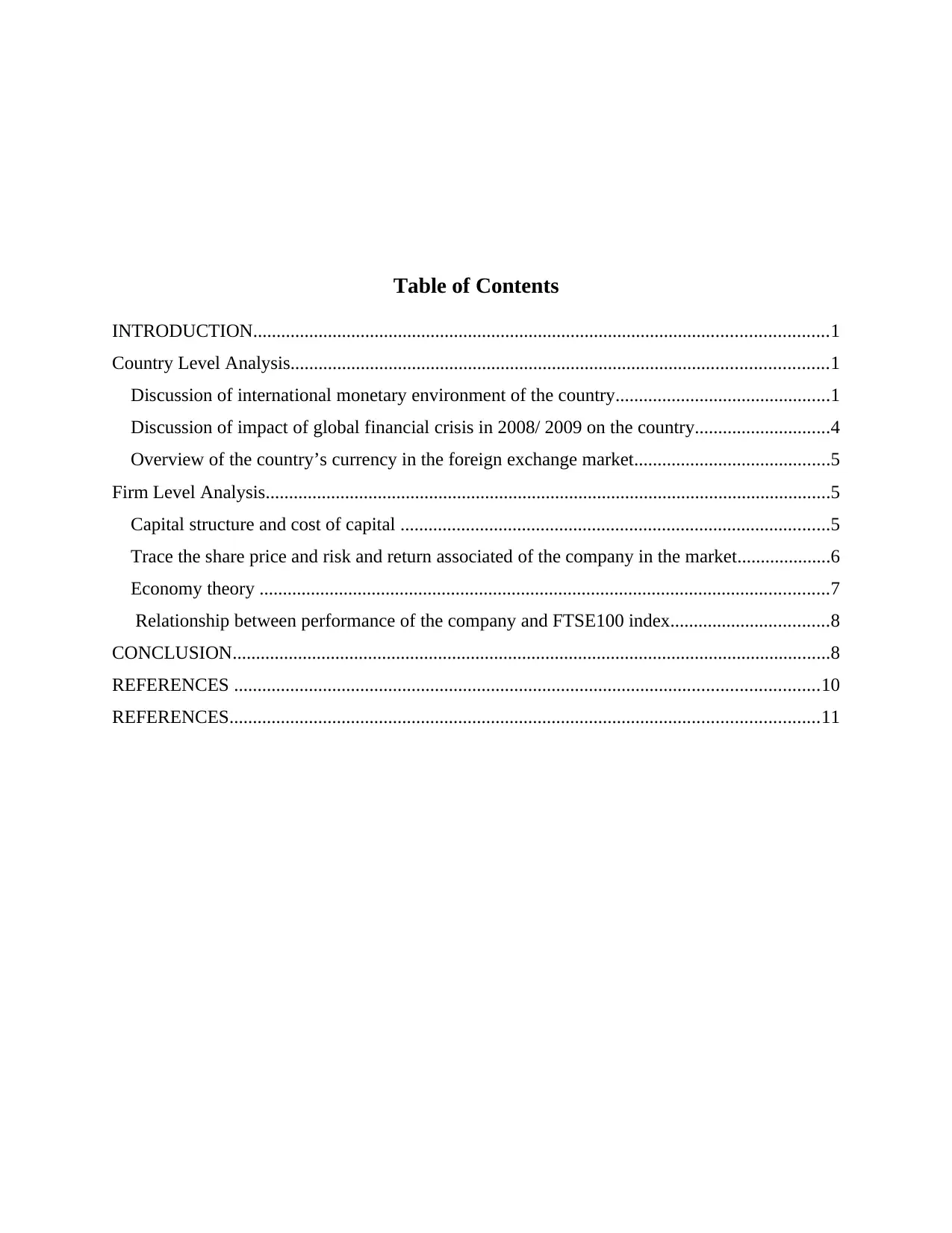
Table of Contents
INTRODUCTION...........................................................................................................................1
Country Level Analysis...................................................................................................................1
Discussion of international monetary environment of the country..............................................1
Discussion of impact of global financial crisis in 2008/ 2009 on the country.............................4
Overview of the country’s currency in the foreign exchange market..........................................5
Firm Level Analysis.........................................................................................................................5
Capital structure and cost of capital ............................................................................................5
Trace the share price and risk and return associated of the company in the market....................6
Economy theory ..........................................................................................................................7
Relationship between performance of the company and FTSE100 index..................................8
CONCLUSION................................................................................................................................8
REFERENCES .............................................................................................................................10
REFERENCES..............................................................................................................................11
INTRODUCTION...........................................................................................................................1
Country Level Analysis...................................................................................................................1
Discussion of international monetary environment of the country..............................................1
Discussion of impact of global financial crisis in 2008/ 2009 on the country.............................4
Overview of the country’s currency in the foreign exchange market..........................................5
Firm Level Analysis.........................................................................................................................5
Capital structure and cost of capital ............................................................................................5
Trace the share price and risk and return associated of the company in the market....................6
Economy theory ..........................................................................................................................7
Relationship between performance of the company and FTSE100 index..................................8
CONCLUSION................................................................................................................................8
REFERENCES .............................................................................................................................10
REFERENCES..............................................................................................................................11
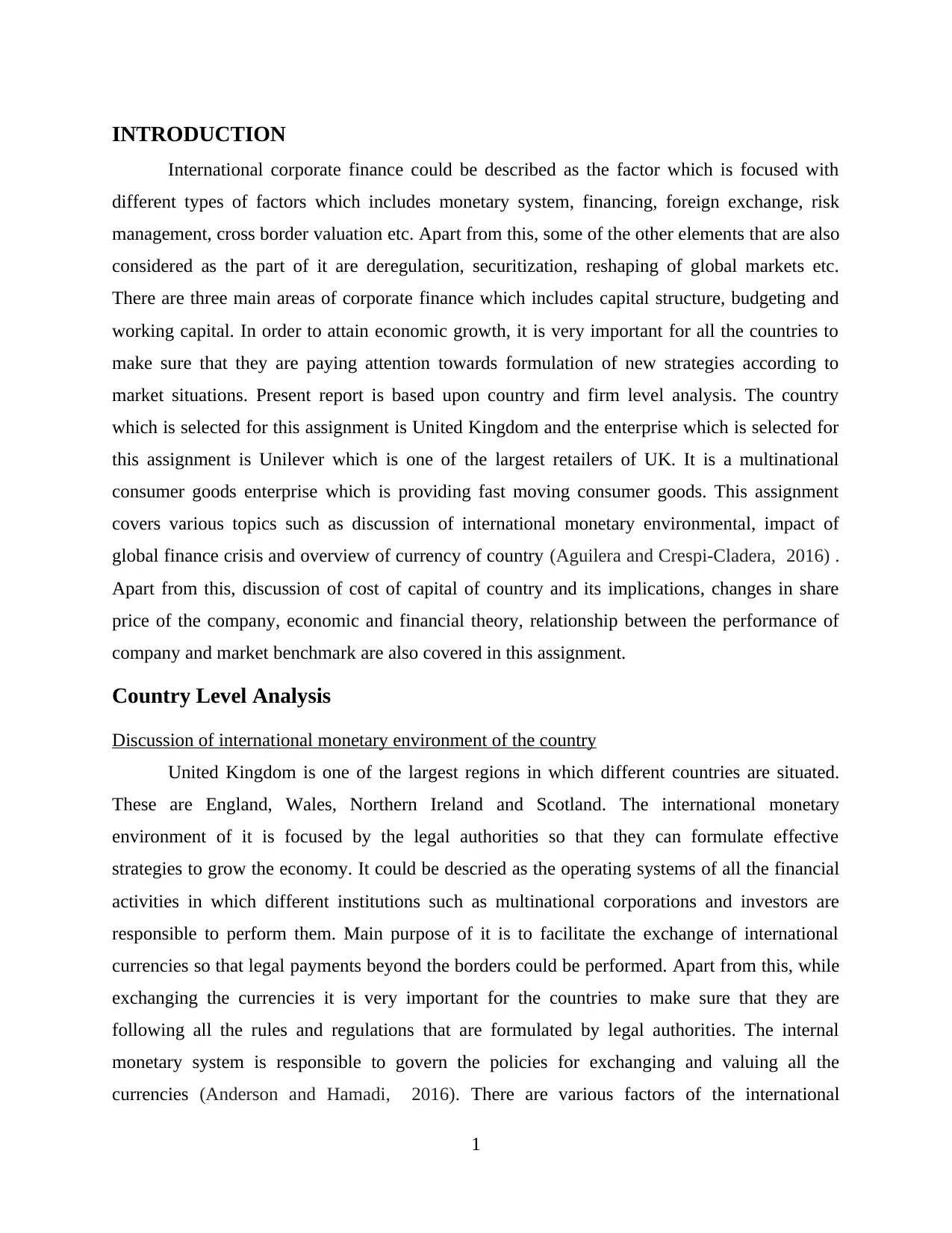
INTRODUCTION
International corporate finance could be described as the factor which is focused with
different types of factors which includes monetary system, financing, foreign exchange, risk
management, cross border valuation etc. Apart from this, some of the other elements that are also
considered as the part of it are deregulation, securitization, reshaping of global markets etc.
There are three main areas of corporate finance which includes capital structure, budgeting and
working capital. In order to attain economic growth, it is very important for all the countries to
make sure that they are paying attention towards formulation of new strategies according to
market situations. Present report is based upon country and firm level analysis. The country
which is selected for this assignment is United Kingdom and the enterprise which is selected for
this assignment is Unilever which is one of the largest retailers of UK. It is a multinational
consumer goods enterprise which is providing fast moving consumer goods. This assignment
covers various topics such as discussion of international monetary environmental, impact of
global finance crisis and overview of currency of country (Aguilera and Crespi-Cladera, 2016) .
Apart from this, discussion of cost of capital of country and its implications, changes in share
price of the company, economic and financial theory, relationship between the performance of
company and market benchmark are also covered in this assignment.
Country Level Analysis
Discussion of international monetary environment of the country
United Kingdom is one of the largest regions in which different countries are situated.
These are England, Wales, Northern Ireland and Scotland. The international monetary
environment of it is focused by the legal authorities so that they can formulate effective
strategies to grow the economy. It could be descried as the operating systems of all the financial
activities in which different institutions such as multinational corporations and investors are
responsible to perform them. Main purpose of it is to facilitate the exchange of international
currencies so that legal payments beyond the borders could be performed. Apart from this, while
exchanging the currencies it is very important for the countries to make sure that they are
following all the rules and regulations that are formulated by legal authorities. The internal
monetary system is responsible to govern the policies for exchanging and valuing all the
currencies (Anderson and Hamadi, 2016). There are various factors of the international
1
International corporate finance could be described as the factor which is focused with
different types of factors which includes monetary system, financing, foreign exchange, risk
management, cross border valuation etc. Apart from this, some of the other elements that are also
considered as the part of it are deregulation, securitization, reshaping of global markets etc.
There are three main areas of corporate finance which includes capital structure, budgeting and
working capital. In order to attain economic growth, it is very important for all the countries to
make sure that they are paying attention towards formulation of new strategies according to
market situations. Present report is based upon country and firm level analysis. The country
which is selected for this assignment is United Kingdom and the enterprise which is selected for
this assignment is Unilever which is one of the largest retailers of UK. It is a multinational
consumer goods enterprise which is providing fast moving consumer goods. This assignment
covers various topics such as discussion of international monetary environmental, impact of
global finance crisis and overview of currency of country (Aguilera and Crespi-Cladera, 2016) .
Apart from this, discussion of cost of capital of country and its implications, changes in share
price of the company, economic and financial theory, relationship between the performance of
company and market benchmark are also covered in this assignment.
Country Level Analysis
Discussion of international monetary environment of the country
United Kingdom is one of the largest regions in which different countries are situated.
These are England, Wales, Northern Ireland and Scotland. The international monetary
environment of it is focused by the legal authorities so that they can formulate effective
strategies to grow the economy. It could be descried as the operating systems of all the financial
activities in which different institutions such as multinational corporations and investors are
responsible to perform them. Main purpose of it is to facilitate the exchange of international
currencies so that legal payments beyond the borders could be performed. Apart from this, while
exchanging the currencies it is very important for the countries to make sure that they are
following all the rules and regulations that are formulated by legal authorities. The internal
monetary system is responsible to govern the policies for exchanging and valuing all the
currencies (Anderson and Hamadi, 2016). There are various factors of the international
1
⊘ This is a preview!⊘
Do you want full access?
Subscribe today to unlock all pages.

Trusted by 1+ million students worldwide
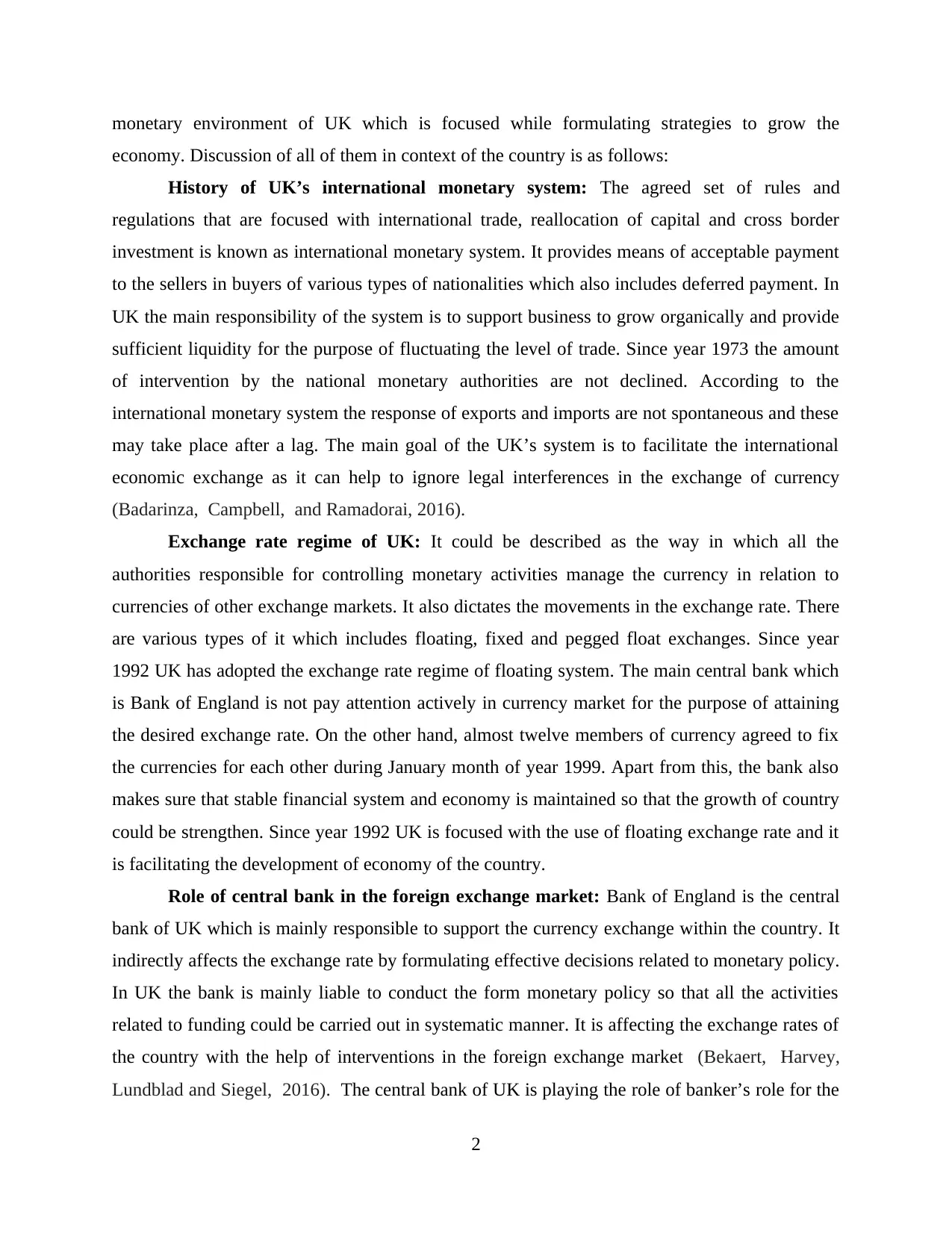
monetary environment of UK which is focused while formulating strategies to grow the
economy. Discussion of all of them in context of the country is as follows:
History of UK’s international monetary system: The agreed set of rules and
regulations that are focused with international trade, reallocation of capital and cross border
investment is known as international monetary system. It provides means of acceptable payment
to the sellers in buyers of various types of nationalities which also includes deferred payment. In
UK the main responsibility of the system is to support business to grow organically and provide
sufficient liquidity for the purpose of fluctuating the level of trade. Since year 1973 the amount
of intervention by the national monetary authorities are not declined. According to the
international monetary system the response of exports and imports are not spontaneous and these
may take place after a lag. The main goal of the UK’s system is to facilitate the international
economic exchange as it can help to ignore legal interferences in the exchange of currency
(Badarinza, Campbell, and Ramadorai, 2016).
Exchange rate regime of UK: It could be described as the way in which all the
authorities responsible for controlling monetary activities manage the currency in relation to
currencies of other exchange markets. It also dictates the movements in the exchange rate. There
are various types of it which includes floating, fixed and pegged float exchanges. Since year
1992 UK has adopted the exchange rate regime of floating system. The main central bank which
is Bank of England is not pay attention actively in currency market for the purpose of attaining
the desired exchange rate. On the other hand, almost twelve members of currency agreed to fix
the currencies for each other during January month of year 1999. Apart from this, the bank also
makes sure that stable financial system and economy is maintained so that the growth of country
could be strengthen. Since year 1992 UK is focused with the use of floating exchange rate and it
is facilitating the development of economy of the country.
Role of central bank in the foreign exchange market: Bank of England is the central
bank of UK which is mainly responsible to support the currency exchange within the country. It
indirectly affects the exchange rate by formulating effective decisions related to monetary policy.
In UK the bank is mainly liable to conduct the form monetary policy so that all the activities
related to funding could be carried out in systematic manner. It is affecting the exchange rates of
the country with the help of interventions in the foreign exchange market (Bekaert, Harvey,
Lundblad and Siegel, 2016). The central bank of UK is playing the role of banker’s role for the
2
economy. Discussion of all of them in context of the country is as follows:
History of UK’s international monetary system: The agreed set of rules and
regulations that are focused with international trade, reallocation of capital and cross border
investment is known as international monetary system. It provides means of acceptable payment
to the sellers in buyers of various types of nationalities which also includes deferred payment. In
UK the main responsibility of the system is to support business to grow organically and provide
sufficient liquidity for the purpose of fluctuating the level of trade. Since year 1973 the amount
of intervention by the national monetary authorities are not declined. According to the
international monetary system the response of exports and imports are not spontaneous and these
may take place after a lag. The main goal of the UK’s system is to facilitate the international
economic exchange as it can help to ignore legal interferences in the exchange of currency
(Badarinza, Campbell, and Ramadorai, 2016).
Exchange rate regime of UK: It could be described as the way in which all the
authorities responsible for controlling monetary activities manage the currency in relation to
currencies of other exchange markets. It also dictates the movements in the exchange rate. There
are various types of it which includes floating, fixed and pegged float exchanges. Since year
1992 UK has adopted the exchange rate regime of floating system. The main central bank which
is Bank of England is not pay attention actively in currency market for the purpose of attaining
the desired exchange rate. On the other hand, almost twelve members of currency agreed to fix
the currencies for each other during January month of year 1999. Apart from this, the bank also
makes sure that stable financial system and economy is maintained so that the growth of country
could be strengthen. Since year 1992 UK is focused with the use of floating exchange rate and it
is facilitating the development of economy of the country.
Role of central bank in the foreign exchange market: Bank of England is the central
bank of UK which is mainly responsible to support the currency exchange within the country. It
indirectly affects the exchange rate by formulating effective decisions related to monetary policy.
In UK the bank is mainly liable to conduct the form monetary policy so that all the activities
related to funding could be carried out in systematic manner. It is affecting the exchange rates of
the country with the help of interventions in the foreign exchange market (Bekaert, Harvey,
Lundblad and Siegel, 2016). The central bank of UK is playing the role of banker’s role for the
2
Paraphrase This Document
Need a fresh take? Get an instant paraphrase of this document with our AI Paraphraser
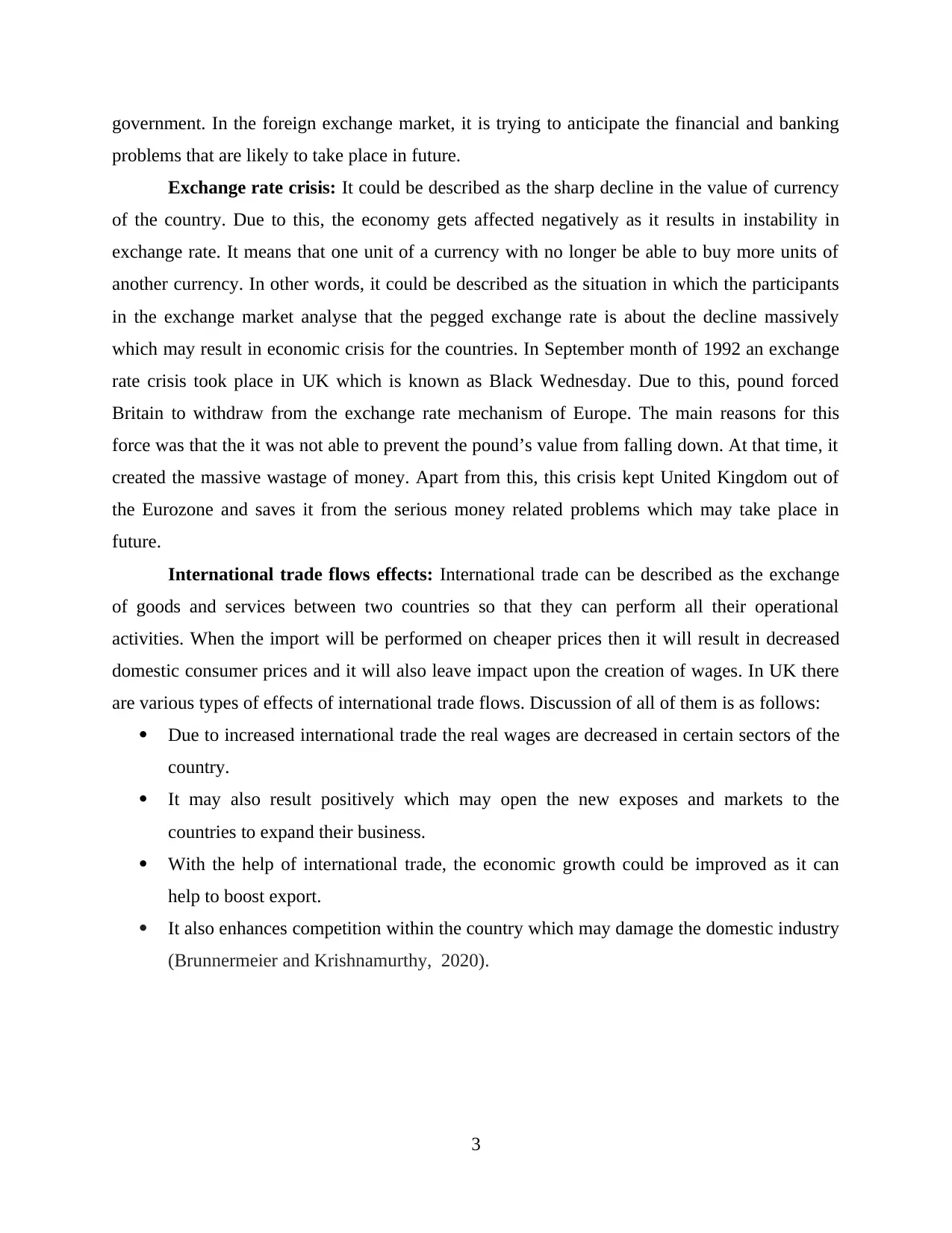
government. In the foreign exchange market, it is trying to anticipate the financial and banking
problems that are likely to take place in future.
Exchange rate crisis: It could be described as the sharp decline in the value of currency
of the country. Due to this, the economy gets affected negatively as it results in instability in
exchange rate. It means that one unit of a currency with no longer be able to buy more units of
another currency. In other words, it could be described as the situation in which the participants
in the exchange market analyse that the pegged exchange rate is about the decline massively
which may result in economic crisis for the countries. In September month of 1992 an exchange
rate crisis took place in UK which is known as Black Wednesday. Due to this, pound forced
Britain to withdraw from the exchange rate mechanism of Europe. The main reasons for this
force was that the it was not able to prevent the pound’s value from falling down. At that time, it
created the massive wastage of money. Apart from this, this crisis kept United Kingdom out of
the Eurozone and saves it from the serious money related problems which may take place in
future.
International trade flows effects: International trade can be described as the exchange
of goods and services between two countries so that they can perform all their operational
activities. When the import will be performed on cheaper prices then it will result in decreased
domestic consumer prices and it will also leave impact upon the creation of wages. In UK there
are various types of effects of international trade flows. Discussion of all of them is as follows:
Due to increased international trade the real wages are decreased in certain sectors of the
country.
It may also result positively which may open the new exposes and markets to the
countries to expand their business.
With the help of international trade, the economic growth could be improved as it can
help to boost export.
It also enhances competition within the country which may damage the domestic industry
(Brunnermeier and Krishnamurthy, 2020).
3
problems that are likely to take place in future.
Exchange rate crisis: It could be described as the sharp decline in the value of currency
of the country. Due to this, the economy gets affected negatively as it results in instability in
exchange rate. It means that one unit of a currency with no longer be able to buy more units of
another currency. In other words, it could be described as the situation in which the participants
in the exchange market analyse that the pegged exchange rate is about the decline massively
which may result in economic crisis for the countries. In September month of 1992 an exchange
rate crisis took place in UK which is known as Black Wednesday. Due to this, pound forced
Britain to withdraw from the exchange rate mechanism of Europe. The main reasons for this
force was that the it was not able to prevent the pound’s value from falling down. At that time, it
created the massive wastage of money. Apart from this, this crisis kept United Kingdom out of
the Eurozone and saves it from the serious money related problems which may take place in
future.
International trade flows effects: International trade can be described as the exchange
of goods and services between two countries so that they can perform all their operational
activities. When the import will be performed on cheaper prices then it will result in decreased
domestic consumer prices and it will also leave impact upon the creation of wages. In UK there
are various types of effects of international trade flows. Discussion of all of them is as follows:
Due to increased international trade the real wages are decreased in certain sectors of the
country.
It may also result positively which may open the new exposes and markets to the
countries to expand their business.
With the help of international trade, the economic growth could be improved as it can
help to boost export.
It also enhances competition within the country which may damage the domestic industry
(Brunnermeier and Krishnamurthy, 2020).
3
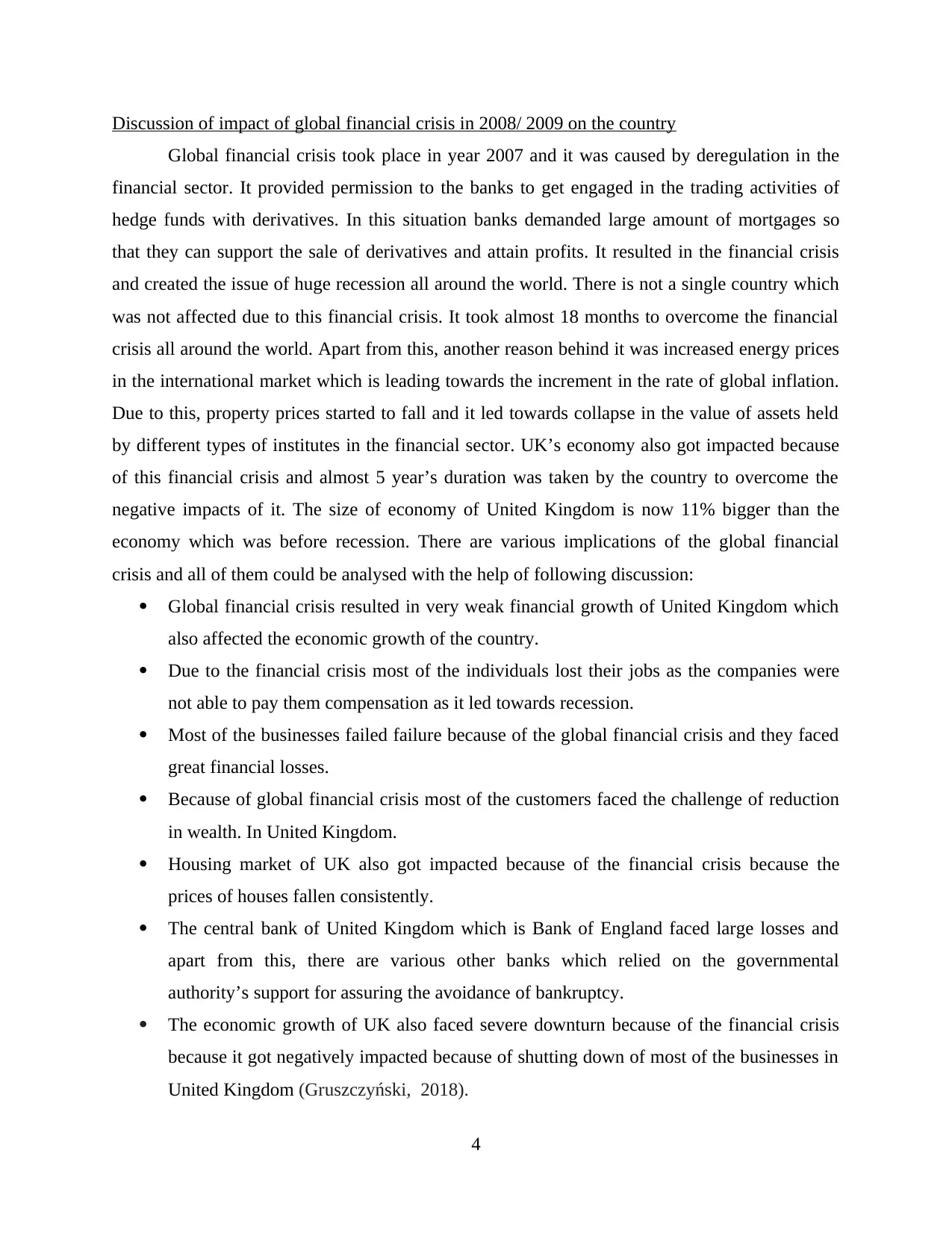
Discussion of impact of global financial crisis in 2008/ 2009 on the country
Global financial crisis took place in year 2007 and it was caused by deregulation in the
financial sector. It provided permission to the banks to get engaged in the trading activities of
hedge funds with derivatives. In this situation banks demanded large amount of mortgages so
that they can support the sale of derivatives and attain profits. It resulted in the financial crisis
and created the issue of huge recession all around the world. There is not a single country which
was not affected due to this financial crisis. It took almost 18 months to overcome the financial
crisis all around the world. Apart from this, another reason behind it was increased energy prices
in the international market which is leading towards the increment in the rate of global inflation.
Due to this, property prices started to fall and it led towards collapse in the value of assets held
by different types of institutes in the financial sector. UK’s economy also got impacted because
of this financial crisis and almost 5 year’s duration was taken by the country to overcome the
negative impacts of it. The size of economy of United Kingdom is now 11% bigger than the
economy which was before recession. There are various implications of the global financial
crisis and all of them could be analysed with the help of following discussion:
Global financial crisis resulted in very weak financial growth of United Kingdom which
also affected the economic growth of the country.
Due to the financial crisis most of the individuals lost their jobs as the companies were
not able to pay them compensation as it led towards recession.
Most of the businesses failed failure because of the global financial crisis and they faced
great financial losses.
Because of global financial crisis most of the customers faced the challenge of reduction
in wealth. In United Kingdom.
Housing market of UK also got impacted because of the financial crisis because the
prices of houses fallen consistently.
The central bank of United Kingdom which is Bank of England faced large losses and
apart from this, there are various other banks which relied on the governmental
authority’s support for assuring the avoidance of bankruptcy.
The economic growth of UK also faced severe downturn because of the financial crisis
because it got negatively impacted because of shutting down of most of the businesses in
United Kingdom (Gruszczyński, 2018).
4
Global financial crisis took place in year 2007 and it was caused by deregulation in the
financial sector. It provided permission to the banks to get engaged in the trading activities of
hedge funds with derivatives. In this situation banks demanded large amount of mortgages so
that they can support the sale of derivatives and attain profits. It resulted in the financial crisis
and created the issue of huge recession all around the world. There is not a single country which
was not affected due to this financial crisis. It took almost 18 months to overcome the financial
crisis all around the world. Apart from this, another reason behind it was increased energy prices
in the international market which is leading towards the increment in the rate of global inflation.
Due to this, property prices started to fall and it led towards collapse in the value of assets held
by different types of institutes in the financial sector. UK’s economy also got impacted because
of this financial crisis and almost 5 year’s duration was taken by the country to overcome the
negative impacts of it. The size of economy of United Kingdom is now 11% bigger than the
economy which was before recession. There are various implications of the global financial
crisis and all of them could be analysed with the help of following discussion:
Global financial crisis resulted in very weak financial growth of United Kingdom which
also affected the economic growth of the country.
Due to the financial crisis most of the individuals lost their jobs as the companies were
not able to pay them compensation as it led towards recession.
Most of the businesses failed failure because of the global financial crisis and they faced
great financial losses.
Because of global financial crisis most of the customers faced the challenge of reduction
in wealth. In United Kingdom.
Housing market of UK also got impacted because of the financial crisis because the
prices of houses fallen consistently.
The central bank of United Kingdom which is Bank of England faced large losses and
apart from this, there are various other banks which relied on the governmental
authority’s support for assuring the avoidance of bankruptcy.
The economic growth of UK also faced severe downturn because of the financial crisis
because it got negatively impacted because of shutting down of most of the businesses in
United Kingdom (Gruszczyński, 2018).
4
⊘ This is a preview!⊘
Do you want full access?
Subscribe today to unlock all pages.

Trusted by 1+ million students worldwide
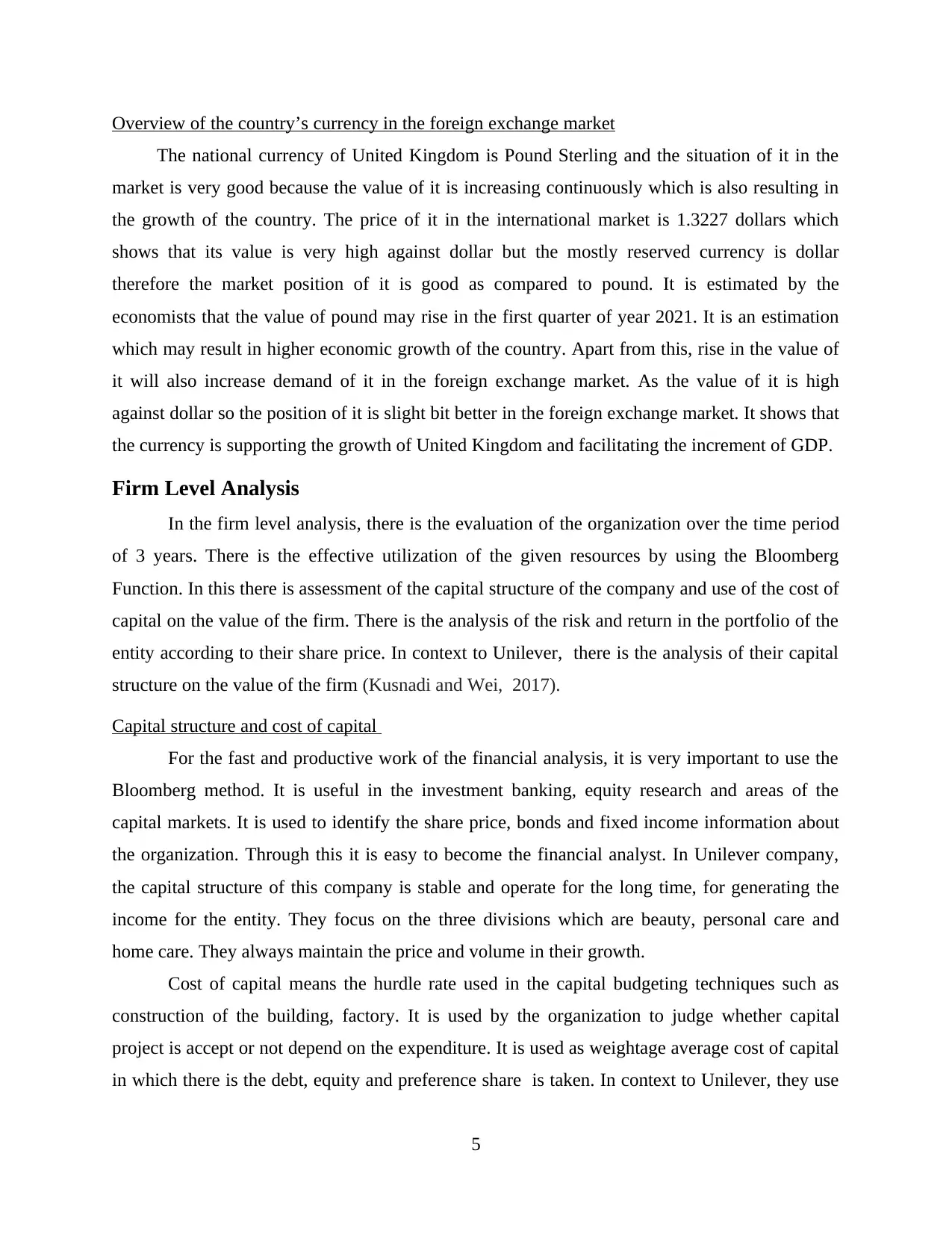
Overview of the country’s currency in the foreign exchange market
The national currency of United Kingdom is Pound Sterling and the situation of it in the
market is very good because the value of it is increasing continuously which is also resulting in
the growth of the country. The price of it in the international market is 1.3227 dollars which
shows that its value is very high against dollar but the mostly reserved currency is dollar
therefore the market position of it is good as compared to pound. It is estimated by the
economists that the value of pound may rise in the first quarter of year 2021. It is an estimation
which may result in higher economic growth of the country. Apart from this, rise in the value of
it will also increase demand of it in the foreign exchange market. As the value of it is high
against dollar so the position of it is slight bit better in the foreign exchange market. It shows that
the currency is supporting the growth of United Kingdom and facilitating the increment of GDP.
Firm Level Analysis
In the firm level analysis, there is the evaluation of the organization over the time period
of 3 years. There is the effective utilization of the given resources by using the Bloomberg
Function. In this there is assessment of the capital structure of the company and use of the cost of
capital on the value of the firm. There is the analysis of the risk and return in the portfolio of the
entity according to their share price. In context to Unilever, there is the analysis of their capital
structure on the value of the firm (Kusnadi and Wei, 2017).
Capital structure and cost of capital
For the fast and productive work of the financial analysis, it is very important to use the
Bloomberg method. It is useful in the investment banking, equity research and areas of the
capital markets. It is used to identify the share price, bonds and fixed income information about
the organization. Through this it is easy to become the financial analyst. In Unilever company,
the capital structure of this company is stable and operate for the long time, for generating the
income for the entity. They focus on the three divisions which are beauty, personal care and
home care. They always maintain the price and volume in their growth.
Cost of capital means the hurdle rate used in the capital budgeting techniques such as
construction of the building, factory. It is used by the organization to judge whether capital
project is accept or not depend on the expenditure. It is used as weightage average cost of capital
in which there is the debt, equity and preference share is taken. In context to Unilever, they use
5
The national currency of United Kingdom is Pound Sterling and the situation of it in the
market is very good because the value of it is increasing continuously which is also resulting in
the growth of the country. The price of it in the international market is 1.3227 dollars which
shows that its value is very high against dollar but the mostly reserved currency is dollar
therefore the market position of it is good as compared to pound. It is estimated by the
economists that the value of pound may rise in the first quarter of year 2021. It is an estimation
which may result in higher economic growth of the country. Apart from this, rise in the value of
it will also increase demand of it in the foreign exchange market. As the value of it is high
against dollar so the position of it is slight bit better in the foreign exchange market. It shows that
the currency is supporting the growth of United Kingdom and facilitating the increment of GDP.
Firm Level Analysis
In the firm level analysis, there is the evaluation of the organization over the time period
of 3 years. There is the effective utilization of the given resources by using the Bloomberg
Function. In this there is assessment of the capital structure of the company and use of the cost of
capital on the value of the firm. There is the analysis of the risk and return in the portfolio of the
entity according to their share price. In context to Unilever, there is the analysis of their capital
structure on the value of the firm (Kusnadi and Wei, 2017).
Capital structure and cost of capital
For the fast and productive work of the financial analysis, it is very important to use the
Bloomberg method. It is useful in the investment banking, equity research and areas of the
capital markets. It is used to identify the share price, bonds and fixed income information about
the organization. Through this it is easy to become the financial analyst. In Unilever company,
the capital structure of this company is stable and operate for the long time, for generating the
income for the entity. They focus on the three divisions which are beauty, personal care and
home care. They always maintain the price and volume in their growth.
Cost of capital means the hurdle rate used in the capital budgeting techniques such as
construction of the building, factory. It is used by the organization to judge whether capital
project is accept or not depend on the expenditure. It is used as weightage average cost of capital
in which there is the debt, equity and preference share is taken. In context to Unilever, they use
5
Paraphrase This Document
Need a fresh take? Get an instant paraphrase of this document with our AI Paraphraser
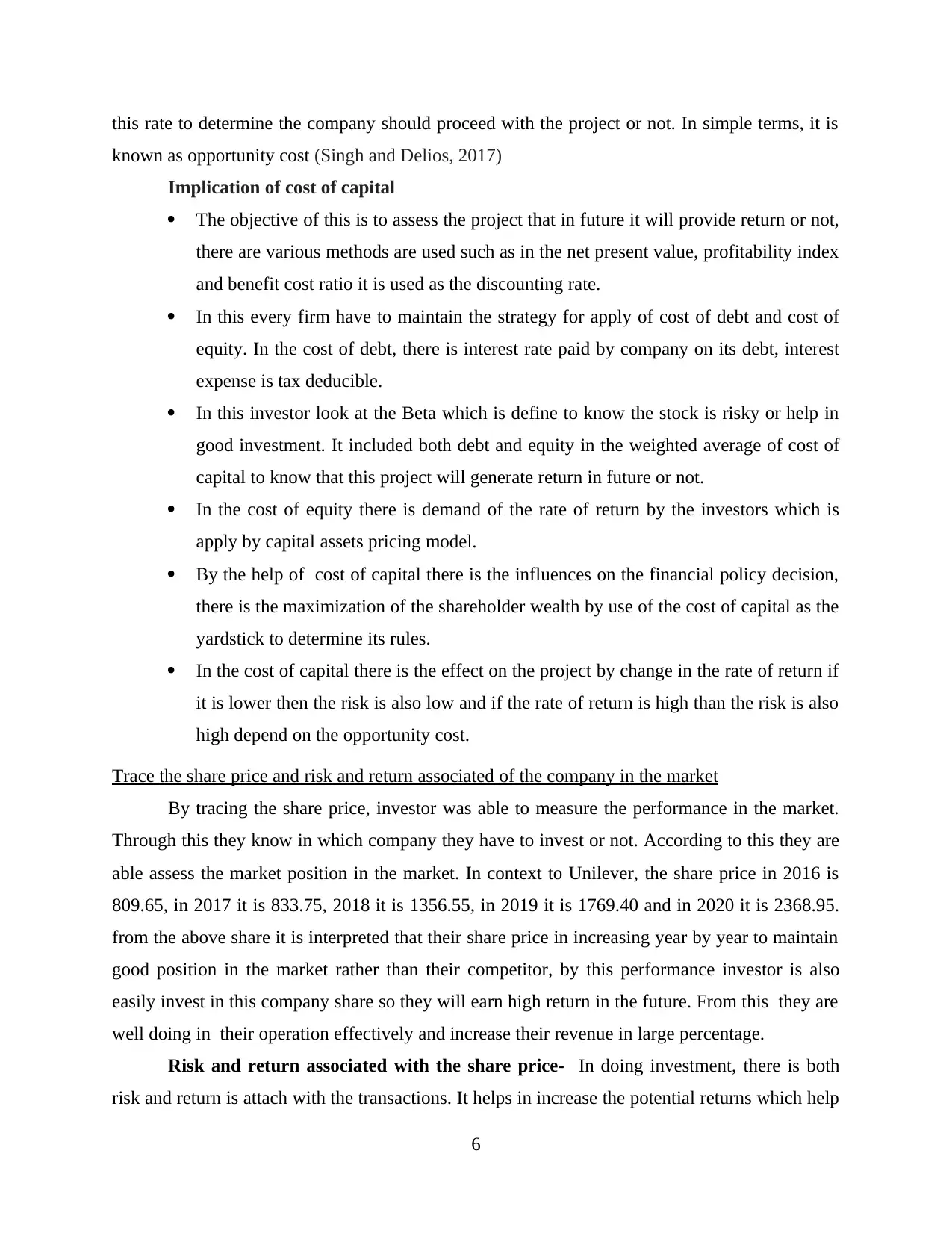
this rate to determine the company should proceed with the project or not. In simple terms, it is
known as opportunity cost (Singh and Delios, 2017)
Implication of cost of capital
The objective of this is to assess the project that in future it will provide return or not,
there are various methods are used such as in the net present value, profitability index
and benefit cost ratio it is used as the discounting rate.
In this every firm have to maintain the strategy for apply of cost of debt and cost of
equity. In the cost of debt, there is interest rate paid by company on its debt, interest
expense is tax deducible.
In this investor look at the Beta which is define to know the stock is risky or help in
good investment. It included both debt and equity in the weighted average of cost of
capital to know that this project will generate return in future or not.
In the cost of equity there is demand of the rate of return by the investors which is
apply by capital assets pricing model.
By the help of cost of capital there is the influences on the financial policy decision,
there is the maximization of the shareholder wealth by use of the cost of capital as the
yardstick to determine its rules.
In the cost of capital there is the effect on the project by change in the rate of return if
it is lower then the risk is also low and if the rate of return is high than the risk is also
high depend on the opportunity cost.
Trace the share price and risk and return associated of the company in the market
By tracing the share price, investor was able to measure the performance in the market.
Through this they know in which company they have to invest or not. According to this they are
able assess the market position in the market. In context to Unilever, the share price in 2016 is
809.65, in 2017 it is 833.75, 2018 it is 1356.55, in 2019 it is 1769.40 and in 2020 it is 2368.95.
from the above share it is interpreted that their share price in increasing year by year to maintain
good position in the market rather than their competitor, by this performance investor is also
easily invest in this company share so they will earn high return in the future. From this they are
well doing in their operation effectively and increase their revenue in large percentage.
Risk and return associated with the share price- In doing investment, there is both
risk and return is attach with the transactions. It helps in increase the potential returns which help
6
known as opportunity cost (Singh and Delios, 2017)
Implication of cost of capital
The objective of this is to assess the project that in future it will provide return or not,
there are various methods are used such as in the net present value, profitability index
and benefit cost ratio it is used as the discounting rate.
In this every firm have to maintain the strategy for apply of cost of debt and cost of
equity. In the cost of debt, there is interest rate paid by company on its debt, interest
expense is tax deducible.
In this investor look at the Beta which is define to know the stock is risky or help in
good investment. It included both debt and equity in the weighted average of cost of
capital to know that this project will generate return in future or not.
In the cost of equity there is demand of the rate of return by the investors which is
apply by capital assets pricing model.
By the help of cost of capital there is the influences on the financial policy decision,
there is the maximization of the shareholder wealth by use of the cost of capital as the
yardstick to determine its rules.
In the cost of capital there is the effect on the project by change in the rate of return if
it is lower then the risk is also low and if the rate of return is high than the risk is also
high depend on the opportunity cost.
Trace the share price and risk and return associated of the company in the market
By tracing the share price, investor was able to measure the performance in the market.
Through this they know in which company they have to invest or not. According to this they are
able assess the market position in the market. In context to Unilever, the share price in 2016 is
809.65, in 2017 it is 833.75, 2018 it is 1356.55, in 2019 it is 1769.40 and in 2020 it is 2368.95.
from the above share it is interpreted that their share price in increasing year by year to maintain
good position in the market rather than their competitor, by this performance investor is also
easily invest in this company share so they will earn high return in the future. From this they are
well doing in their operation effectively and increase their revenue in large percentage.
Risk and return associated with the share price- In doing investment, there is both
risk and return is attach with the transactions. It helps in increase the potential returns which help
6
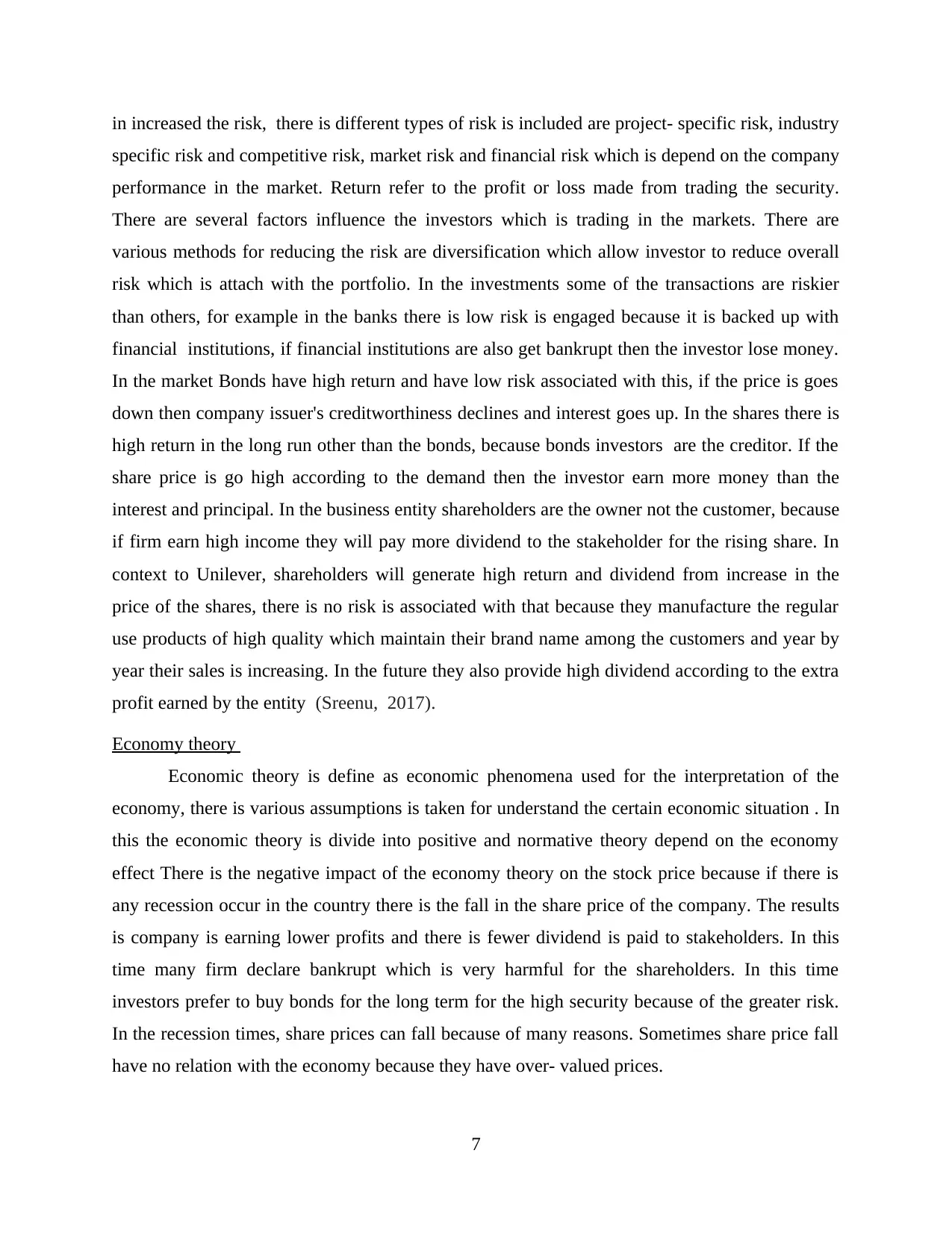
in increased the risk, there is different types of risk is included are project- specific risk, industry
specific risk and competitive risk, market risk and financial risk which is depend on the company
performance in the market. Return refer to the profit or loss made from trading the security.
There are several factors influence the investors which is trading in the markets. There are
various methods for reducing the risk are diversification which allow investor to reduce overall
risk which is attach with the portfolio. In the investments some of the transactions are riskier
than others, for example in the banks there is low risk is engaged because it is backed up with
financial institutions, if financial institutions are also get bankrupt then the investor lose money.
In the market Bonds have high return and have low risk associated with this, if the price is goes
down then company issuer's creditworthiness declines and interest goes up. In the shares there is
high return in the long run other than the bonds, because bonds investors are the creditor. If the
share price is go high according to the demand then the investor earn more money than the
interest and principal. In the business entity shareholders are the owner not the customer, because
if firm earn high income they will pay more dividend to the stakeholder for the rising share. In
context to Unilever, shareholders will generate high return and dividend from increase in the
price of the shares, there is no risk is associated with that because they manufacture the regular
use products of high quality which maintain their brand name among the customers and year by
year their sales is increasing. In the future they also provide high dividend according to the extra
profit earned by the entity (Sreenu, 2017).
Economy theory
Economic theory is define as economic phenomena used for the interpretation of the
economy, there is various assumptions is taken for understand the certain economic situation . In
this the economic theory is divide into positive and normative theory depend on the economy
effect There is the negative impact of the economy theory on the stock price because if there is
any recession occur in the country there is the fall in the share price of the company. The results
is company is earning lower profits and there is fewer dividend is paid to stakeholders. In this
time many firm declare bankrupt which is very harmful for the shareholders. In this time
investors prefer to buy bonds for the long term for the high security because of the greater risk.
In the recession times, share prices can fall because of many reasons. Sometimes share price fall
have no relation with the economy because they have over- valued prices.
7
specific risk and competitive risk, market risk and financial risk which is depend on the company
performance in the market. Return refer to the profit or loss made from trading the security.
There are several factors influence the investors which is trading in the markets. There are
various methods for reducing the risk are diversification which allow investor to reduce overall
risk which is attach with the portfolio. In the investments some of the transactions are riskier
than others, for example in the banks there is low risk is engaged because it is backed up with
financial institutions, if financial institutions are also get bankrupt then the investor lose money.
In the market Bonds have high return and have low risk associated with this, if the price is goes
down then company issuer's creditworthiness declines and interest goes up. In the shares there is
high return in the long run other than the bonds, because bonds investors are the creditor. If the
share price is go high according to the demand then the investor earn more money than the
interest and principal. In the business entity shareholders are the owner not the customer, because
if firm earn high income they will pay more dividend to the stakeholder for the rising share. In
context to Unilever, shareholders will generate high return and dividend from increase in the
price of the shares, there is no risk is associated with that because they manufacture the regular
use products of high quality which maintain their brand name among the customers and year by
year their sales is increasing. In the future they also provide high dividend according to the extra
profit earned by the entity (Sreenu, 2017).
Economy theory
Economic theory is define as economic phenomena used for the interpretation of the
economy, there is various assumptions is taken for understand the certain economic situation . In
this the economic theory is divide into positive and normative theory depend on the economy
effect There is the negative impact of the economy theory on the stock price because if there is
any recession occur in the country there is the fall in the share price of the company. The results
is company is earning lower profits and there is fewer dividend is paid to stakeholders. In this
time many firm declare bankrupt which is very harmful for the shareholders. In this time
investors prefer to buy bonds for the long term for the high security because of the greater risk.
In the recession times, share prices can fall because of many reasons. Sometimes share price fall
have no relation with the economy because they have over- valued prices.
7
⊘ This is a preview!⊘
Do you want full access?
Subscribe today to unlock all pages.

Trusted by 1+ million students worldwide
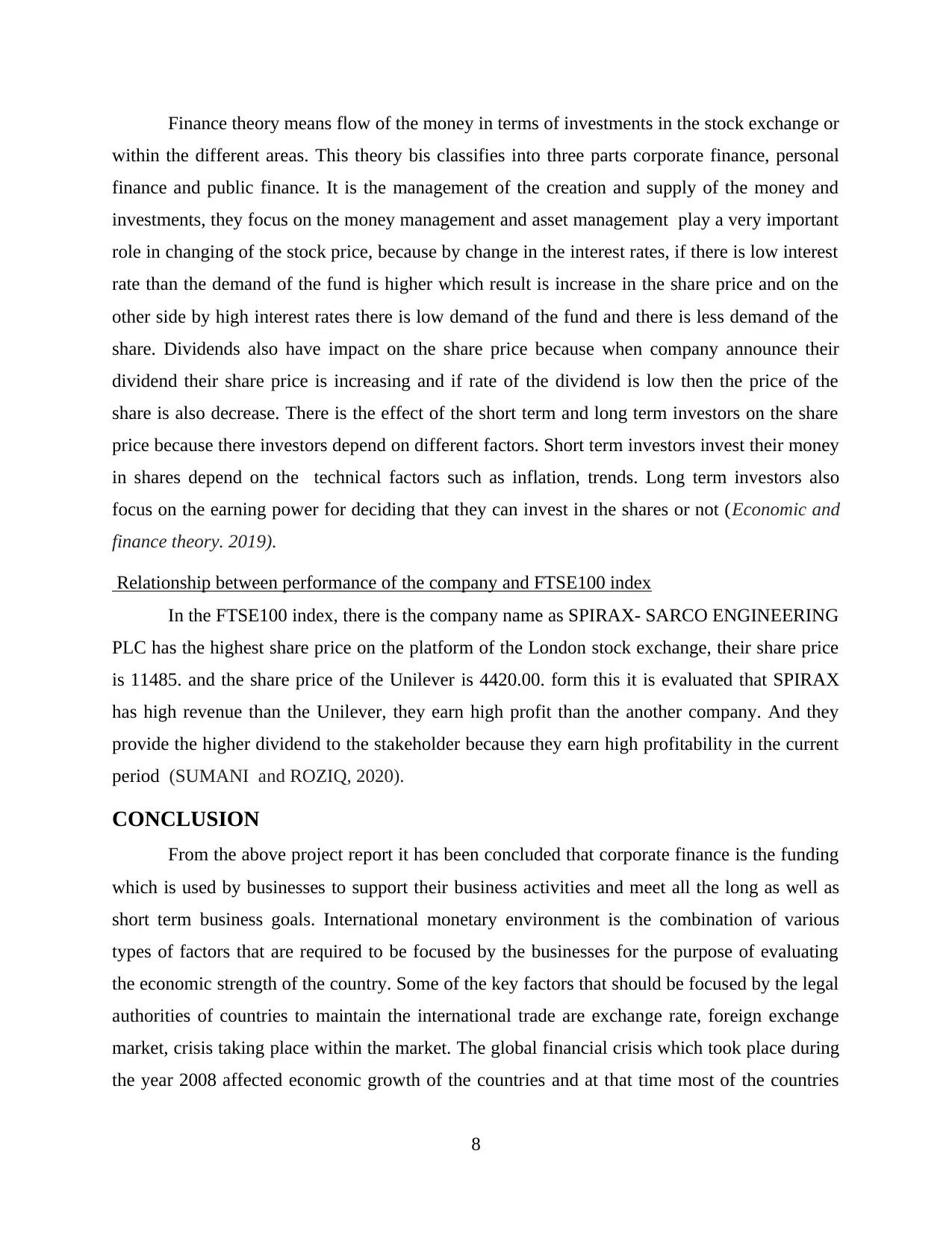
Finance theory means flow of the money in terms of investments in the stock exchange or
within the different areas. This theory bis classifies into three parts corporate finance, personal
finance and public finance. It is the management of the creation and supply of the money and
investments, they focus on the money management and asset management play a very important
role in changing of the stock price, because by change in the interest rates, if there is low interest
rate than the demand of the fund is higher which result is increase in the share price and on the
other side by high interest rates there is low demand of the fund and there is less demand of the
share. Dividends also have impact on the share price because when company announce their
dividend their share price is increasing and if rate of the dividend is low then the price of the
share is also decrease. There is the effect of the short term and long term investors on the share
price because there investors depend on different factors. Short term investors invest their money
in shares depend on the technical factors such as inflation, trends. Long term investors also
focus on the earning power for deciding that they can invest in the shares or not (Economic and
finance theory. 2019).
Relationship between performance of the company and FTSE100 index
In the FTSE100 index, there is the company name as SPIRAX- SARCO ENGINEERING
PLC has the highest share price on the platform of the London stock exchange, their share price
is 11485. and the share price of the Unilever is 4420.00. form this it is evaluated that SPIRAX
has high revenue than the Unilever, they earn high profit than the another company. And they
provide the higher dividend to the stakeholder because they earn high profitability in the current
period (SUMANI and ROZIQ, 2020).
CONCLUSION
From the above project report it has been concluded that corporate finance is the funding
which is used by businesses to support their business activities and meet all the long as well as
short term business goals. International monetary environment is the combination of various
types of factors that are required to be focused by the businesses for the purpose of evaluating
the economic strength of the country. Some of the key factors that should be focused by the legal
authorities of countries to maintain the international trade are exchange rate, foreign exchange
market, crisis taking place within the market. The global financial crisis which took place during
the year 2008 affected economic growth of the countries and at that time most of the countries
8
within the different areas. This theory bis classifies into three parts corporate finance, personal
finance and public finance. It is the management of the creation and supply of the money and
investments, they focus on the money management and asset management play a very important
role in changing of the stock price, because by change in the interest rates, if there is low interest
rate than the demand of the fund is higher which result is increase in the share price and on the
other side by high interest rates there is low demand of the fund and there is less demand of the
share. Dividends also have impact on the share price because when company announce their
dividend their share price is increasing and if rate of the dividend is low then the price of the
share is also decrease. There is the effect of the short term and long term investors on the share
price because there investors depend on different factors. Short term investors invest their money
in shares depend on the technical factors such as inflation, trends. Long term investors also
focus on the earning power for deciding that they can invest in the shares or not (Economic and
finance theory. 2019).
Relationship between performance of the company and FTSE100 index
In the FTSE100 index, there is the company name as SPIRAX- SARCO ENGINEERING
PLC has the highest share price on the platform of the London stock exchange, their share price
is 11485. and the share price of the Unilever is 4420.00. form this it is evaluated that SPIRAX
has high revenue than the Unilever, they earn high profit than the another company. And they
provide the higher dividend to the stakeholder because they earn high profitability in the current
period (SUMANI and ROZIQ, 2020).
CONCLUSION
From the above project report it has been concluded that corporate finance is the funding
which is used by businesses to support their business activities and meet all the long as well as
short term business goals. International monetary environment is the combination of various
types of factors that are required to be focused by the businesses for the purpose of evaluating
the economic strength of the country. Some of the key factors that should be focused by the legal
authorities of countries to maintain the international trade are exchange rate, foreign exchange
market, crisis taking place within the market. The global financial crisis which took place during
the year 2008 affected economic growth of the countries and at that time most of the countries
8
Paraphrase This Document
Need a fresh take? Get an instant paraphrase of this document with our AI Paraphraser
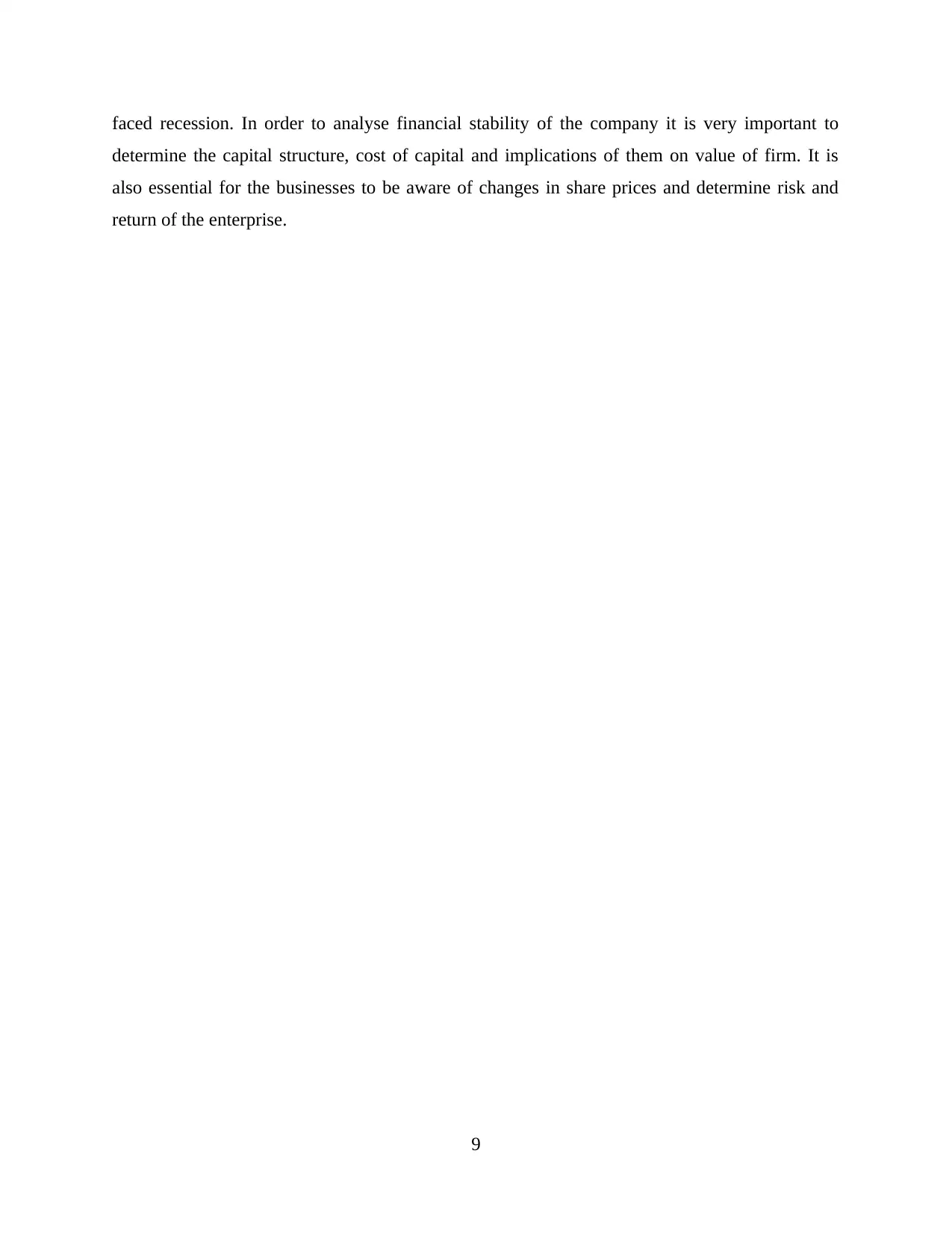
faced recession. In order to analyse financial stability of the company it is very important to
determine the capital structure, cost of capital and implications of them on value of firm. It is
also essential for the businesses to be aware of changes in share prices and determine risk and
return of the enterprise.
9
determine the capital structure, cost of capital and implications of them on value of firm. It is
also essential for the businesses to be aware of changes in share prices and determine risk and
return of the enterprise.
9
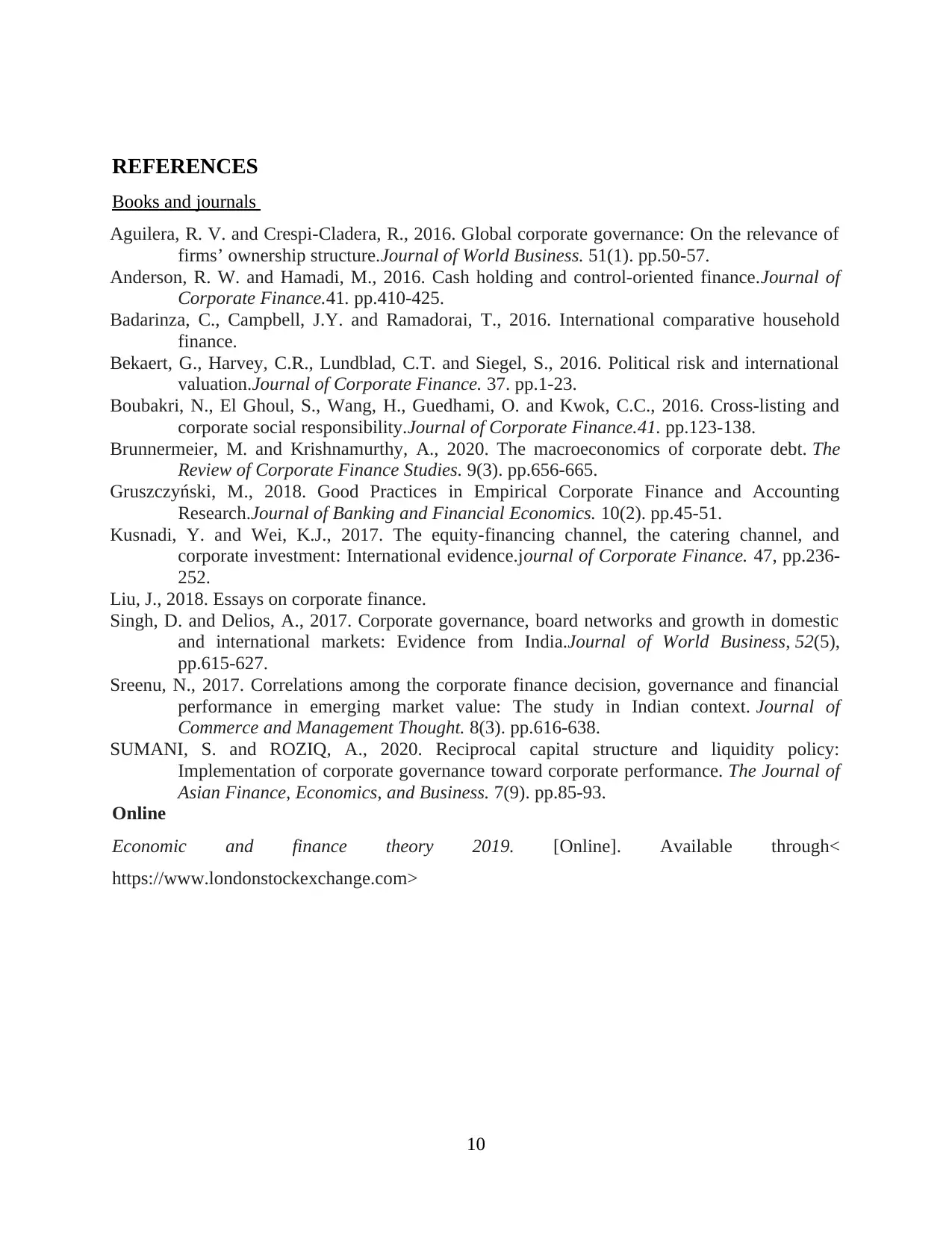
REFERENCES
Books and journals
Aguilera, R. V. and Crespi-Cladera, R., 2016. Global corporate governance: On the relevance of
firms’ ownership structure.Journal of World Business. 51(1). pp.50-57.
Anderson, R. W. and Hamadi, M., 2016. Cash holding and control-oriented finance.Journal of
Corporate Finance.41. pp.410-425.
Badarinza, C., Campbell, J.Y. and Ramadorai, T., 2016. International comparative household
finance.
Bekaert, G., Harvey, C.R., Lundblad, C.T. and Siegel, S., 2016. Political risk and international
valuation.Journal of Corporate Finance. 37. pp.1-23.
Boubakri, N., El Ghoul, S., Wang, H., Guedhami, O. and Kwok, C.C., 2016. Cross-listing and
corporate social responsibility.Journal of Corporate Finance.41. pp.123-138.
Brunnermeier, M. and Krishnamurthy, A., 2020. The macroeconomics of corporate debt. The
Review of Corporate Finance Studies. 9(3). pp.656-665.
Gruszczyński, M., 2018. Good Practices in Empirical Corporate Finance and Accounting
Research.Journal of Banking and Financial Economics. 10(2). pp.45-51.
Kusnadi, Y. and Wei, K.J., 2017. The equity-financing channel, the catering channel, and
corporate investment: International evidence.journal of Corporate Finance. 47, pp.236-
252.
Liu, J., 2018. Essays on corporate finance.
Singh, D. and Delios, A., 2017. Corporate governance, board networks and growth in domestic
and international markets: Evidence from India.Journal of World Business, 52(5),
pp.615-627.
Sreenu, N., 2017. Correlations among the corporate finance decision, governance and financial
performance in emerging market value: The study in Indian context. Journal of
Commerce and Management Thought. 8(3). pp.616-638.
SUMANI, S. and ROZIQ, A., 2020. Reciprocal capital structure and liquidity policy:
Implementation of corporate governance toward corporate performance. The Journal of
Asian Finance, Economics, and Business. 7(9). pp.85-93.
Online
Economic and finance theory 2019. [Online]. Available through<
https://www.londonstockexchange.com>
10
Books and journals
Aguilera, R. V. and Crespi-Cladera, R., 2016. Global corporate governance: On the relevance of
firms’ ownership structure.Journal of World Business. 51(1). pp.50-57.
Anderson, R. W. and Hamadi, M., 2016. Cash holding and control-oriented finance.Journal of
Corporate Finance.41. pp.410-425.
Badarinza, C., Campbell, J.Y. and Ramadorai, T., 2016. International comparative household
finance.
Bekaert, G., Harvey, C.R., Lundblad, C.T. and Siegel, S., 2016. Political risk and international
valuation.Journal of Corporate Finance. 37. pp.1-23.
Boubakri, N., El Ghoul, S., Wang, H., Guedhami, O. and Kwok, C.C., 2016. Cross-listing and
corporate social responsibility.Journal of Corporate Finance.41. pp.123-138.
Brunnermeier, M. and Krishnamurthy, A., 2020. The macroeconomics of corporate debt. The
Review of Corporate Finance Studies. 9(3). pp.656-665.
Gruszczyński, M., 2018. Good Practices in Empirical Corporate Finance and Accounting
Research.Journal of Banking and Financial Economics. 10(2). pp.45-51.
Kusnadi, Y. and Wei, K.J., 2017. The equity-financing channel, the catering channel, and
corporate investment: International evidence.journal of Corporate Finance. 47, pp.236-
252.
Liu, J., 2018. Essays on corporate finance.
Singh, D. and Delios, A., 2017. Corporate governance, board networks and growth in domestic
and international markets: Evidence from India.Journal of World Business, 52(5),
pp.615-627.
Sreenu, N., 2017. Correlations among the corporate finance decision, governance and financial
performance in emerging market value: The study in Indian context. Journal of
Commerce and Management Thought. 8(3). pp.616-638.
SUMANI, S. and ROZIQ, A., 2020. Reciprocal capital structure and liquidity policy:
Implementation of corporate governance toward corporate performance. The Journal of
Asian Finance, Economics, and Business. 7(9). pp.85-93.
Online
Economic and finance theory 2019. [Online]. Available through<
https://www.londonstockexchange.com>
10
⊘ This is a preview!⊘
Do you want full access?
Subscribe today to unlock all pages.

Trusted by 1+ million students worldwide
1 out of 13
Related Documents
Your All-in-One AI-Powered Toolkit for Academic Success.
+13062052269
info@desklib.com
Available 24*7 on WhatsApp / Email
![[object Object]](/_next/static/media/star-bottom.7253800d.svg)
Unlock your academic potential
Copyright © 2020–2025 A2Z Services. All Rights Reserved. Developed and managed by ZUCOL.





